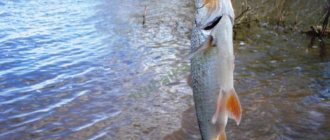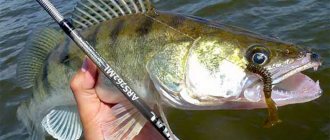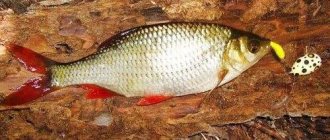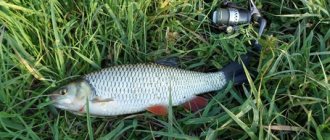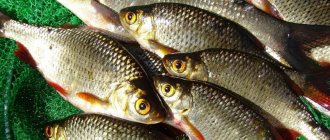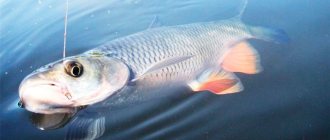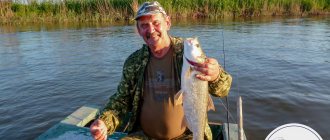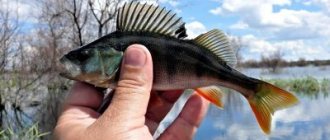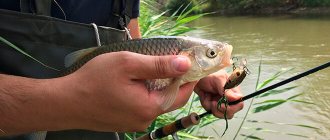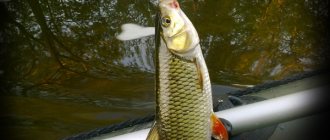Choosing a place to catch chub. Tackle and bait for catching chub in spring? Chub on microjig. Wiring the bait.
Chub fishing in our southern provinces sometimes opens as early as March, more often in April, but during this period the water temperature is still quite low, not exceeding eight degrees, which negatively affects the chub bite. Therefore, the most effective exits of the red-finned predator occur only on quiet sunny days, when the water warms up to some extent in coastal shallows, channel edges and near reed thickets, where the chub also comes to the border of calm water and fast core stream.
What baits are used to catch chub in the spring?
The most exciting and often the most effective, not to mention sporting, is at this time catching chub with small and fast-moving minnow class wobblers. These are miniature baits measuring from three to five centimeters. In addition, microjig is successfully used, where various small baits made of edible rubber are placed on a hook, resembling in appearance either crustaceans, or shrimp, or all combined, their appearance is so exotic, where artificial legs, claws, and tails oscillate in the current. But the chub, not paying attention to the strange appearance of such baits like Hoggy Hog , grabs them and pleases the soul of the fisherman who has missed spinning rods over the winter.
Among the catchy wobblers is the floating bait Owner Selection TMI-53, which also remains stable in the current. Among the sinking wobblers, we can highlight the Tackle House Buffet S43 and Rigge 46S baits.
Lures for chub
- Chub are caught with a variety of different baits such as: dough, bread crust, lard, cheese, meat, liver, pieces of fish.
- Let us also note the natural food for the chub: beetles, dragonflies, various insects, butterflies, maggots, worms, leeches, mollusks, tadpoles of frogs, baby frogs, fry.
- Among the vegetable baits, we note the following: peas, boiled potatoes, steamed grain. Although this may seem surprising, chub are also caught using berries: cherries, currants, gooseberries and mulberries.
For spring chub fishing, you can also use lamprey larvae. They can be dug up in muddy soil near water, but it is worth considering that they may not be available at the planned fishing location.
For spring fishing, larvae of 10 cm in size are taken. If the larvae are smaller, then several can be planted at once. They are inserted through the mouth so that the larva cannot burrow into the ground. You can also use large earthworms.
Let us repeat that the most effective spinning baits for chub are wobblers, then oscillating and rotating spoons; you can read more about them using the links at the top and bottom of the page.
Chub on microjig in spring
For catching chub with microjigs and light baits in general, ultralight class rods are most suitable, as they have good sensitivity, especially when using light baits. At the same time, these rods have a safety margin sufficient for fishing large predators. Typically, such lightweight and durable fishing rods use new technologies, where the structure of the blank material is viscous and twisted, which makes the fishing rods, despite their miniature size, very flexible and durable. However, they remain helpless against shock lateral loads, like all carbon fiber rods.
Choosing a fishing spot
As already mentioned, the chub is a very shy and distrustful fish with excellent eyesight. When he sees a fisherman, he will prefer to leave, regardless of the alluring baits. Therefore, it is better to catch it off the coast, where there are trees and bushes behind which you can hide. If there are no such shelters, it is advisable to position yourself near the river so that the sun is not behind you: bright rays illuminating your silhouette will tell the chub about your presence. If the fish does not notice anything suspicious, it will boldly swallow the bait.
It is also worth considering that the chub loves places with fast currents and often lives in rapids, river bends, and channels between islands. This fish especially loves places where currents meet, where the water is most saturated with oxygen. But if you are fishing on a large river, then it is worth remembering that the chub prefers the outback, located near the shore, with calmly flowing water.
Since the chub spawns at the end of April, at the beginning of May, after a week's rest from spawning, the fish begins to eat, which makes fishing much easier for fishermen. But despite the fish’s not being picky about food, you need to know exactly what to catch chub with in May, and what gear is best to use.
Braid and bait wiring
To catch chub in the spring with a spinning rod, it is best to use a thin and durable braided cord, which, without having windage and stretch, unlike monofilament, allows you to move the bait in a controlled manner and is sensitive to the touch of a predator and bites. A braided cord has the ability to “cut” current streams, which a monofilament line cannot, which usually bends under the pressure of the current and stretches, reacting poorly to bites and not allowing the bait to be guided in the desired mode of play, which is usually jerking - twitching. The principle of retrieving is to reel in the bait while simultaneously twitching the tackle with the tip of the rod. Sometimes pauses are made and often during these pauses an interested chub bites.
Features of the chub
The chub is a fairly large, strong and beautiful inhabitant of the freshwater rivers of Europe. The most prominent individuals of this species reach a length of about 80 cm and weigh more than 8 kg. The fish is a semi-predatory fish; its diet includes bottom mollusks, insects, larvae, caterpillars and midges found in the upper layers of water, as well as algae growing on snags and mud.
The body of the fish has an elongated cylindrical shape, which allows it to swim at great speed even in fast currents. Its habitat is medium and small rivers with fast-flowing water. These can be both flat and mountain reservoirs. Chub prefer fast currents and sandy or rocky bottoms. It is most often found in rivers with rapids, riffles and bends in the channel. This fish loves to hunt under cliffs or banks, with trees or bushes hanging over the water, from which caterpillars, midges or other prey often fall. In early May, the chub really likes to feed on chafer beetles, which begin their flight just at this time.
This fish is very wary of the presence of people, so when fishing it is undesirable to make noise or use flashy gear. This will scare away the fish and you will not get the desired catch.
What else do you use to catch chub in the spring?
But not only spinners have the opportunity to catch chub in the spring. These silvery predators sometimes no less greedily grab a brush of worms on a feeder hook or even a hook, as long as the tackle is not for burbot, that is, relatively miniature. Moreover, small narrow-bodied fish, for example, gudgeon, bleak and verkhovka, can also serve as bait. At the beginning of summer, when the full season of open water opens, you can catch chub even with summer fliers, using gudgeon, which will be the best live bait. At least, such fishing was practiced on the Yaran River, where the girders were hung directly on the bushes hanging over the water.
Asp and chub in spring on a water-filling float
What to catch chub with
Promising places for catching chub in spring
At the very beginning of spring, chubs stay near the bottom with various shelters, thanks to which they spend less energy fighting the water flow. These could be submerged snags, boulders, or bottom surface anomalies. You can also hide from a strong jet behind the supports of hydraulic structures or in pockets washed out by the current in steep banks. This predator is rarely found above a muddy bottom; it prefers soil with a solid structure: stone, gravel, sand, clay.
After spawning, the chub returns to its usual places, where it can be caught until the end of the season. Now you should look for it:
- on shallows, sand spits, rifts with an anomalous bottom and average current;
- in places where streams and small rivers flow into the main channel, which bring a lot of food;
- near existing and destroyed hydraulic structures (bridges, dams, water mills and others);
- near islands and islets dividing the river flow;
- in stuck areas with a depth of up to 2-3 meters;
- in places where there are many trees on the shore, the branches of which hang over the water;
- over an uneven bottom with ditches and humps, on steep slopes to depth.
For the bighead, shelter is more important than food. You can hide behind a stone or a block from large enemies, and the food will float by itself. For example, a small fish that has virtually no chance of escaping after being attacked by a chub from an ambush.
The best baits for catching chub
Since the chub can be called an omnivore, the bait can be very diverse. After high water, when the water has not yet completely cleared, chub can be caught well with worms. He also does not disdain baits in the form of offal, liver, pieces of sausage or frankfurters, pieces of fish or stale meat, maggots and shellfish. Processed cheese, various insects and their larvae, and frogs can also serve as bait. It is good to use leeches as bait. Particular attention should be paid to grasshoppers, which are also a delicacy for chub.
If you have not yet decided what to catch chub with in May, you can use vegetable bait. Boiled potatoes, peas or pearl barley are good for this. Chub can also be caught using bread, in particular crust. Some fishermen claim that sometimes the fish simply ignore the best baits, choosing a crust of white bread.
When catching chub, you need to take into account that although it is an omnivore, its preferences can change quickly, and it is impossible to determine exactly what it will like at a certain moment. When going fishing, it is better to take several types of bait with you. It also happens that in one place the fish will bite well on maggots, and in another they will choose pearl barley. You can determine what is best for catching chub by systematically throwing a variety of bait.
How to catch chub with a float rod?
An excellent tackle for chub is a float rod. The rod must be very powerful, since the fish is desperately fighting for its freedom, and if you manage to hook an individual weighing 2-3 kg, then a weak rod will not withstand the pressure. The line can be 0.18 mm thick. Since the spring river after high water is full of different hooks, be sure to use a leash. Depending on the baits and attachments used, select the appropriate hook (7-12).
When equipping tackle for chub, use floats that allow you to fix the structure in fairly fast currents. They should not be heavy and weigh more than 10 g, since splashing can scare the fish and there will be no catch. The carrying capacity of the float depends on the depth at which fishing is planned.
If fishing takes place in shallow water, you can use a nod instead of a float. The summer jig fishing rod has one difficulty: since the fish bites very carefully, it is not always possible to recognize it.
How to catch the cockchafer?
In May, it is good to catch chub using the cockchafer. But this period does not last long, so it is advisable to take advantage of the fish’s weakness to insects in time.
After the May beetle flies out, there are no problems with catching it: the beetles just swarm near the trees. They can easily be caught in flight using a butterfly net. They need to be placed in a container that has holes for free air circulation. To bait a beetle on a hook, you need to pierce the back with a sting between the wings so that it comes out of the abdomen. Such baiting will not allow the chub to feast on the bitten off part of the beetle. The sting should be on the outside.
Since the chub prefers sinking beetles, the bait should be systematically re-cast. This will improve the bite.
In the spring, the chub bites well on the cockchafer for about a week, just after the insect has fledged. Then he begins to sort through the baits. That’s why it’s so important not to miss the right moment.
Tactics for catching chub in May with a jig
On the rifts, chub fishing in May is usually done from a coastal spit or by wading. The most suitable tackle for such fishing is a fishing rod with a jig without a float and sinker. A fishing rod 4-5 m long is equipped with guide rings and a reel with a line reserve (0.20-0.25 mm) of at least 25-30 m.
A jig with a worm, maggot, beetle larva, or a pellet of bread or dough attachment is released with the flow and then slowly pulled up. It is very important that the bait is more often at the bottom and in half-water, since the current tends to constantly bring it to the surface. This is achieved by frequently tilting the rod towards the water. The bite can be felt well by hand.
After catching one or two fish, the bite usually stops for a while. Therefore, you immediately need to identify at least one more place for fishing nearby.
Industrially made jigs, which are light in weight and have a small hook size, are not suitable - there are too many misses when hooking and fish coming off the hook. The best homemade jigs are drop-shaped, 20 mm long, with hook No. 6.
By the way, you can catch chub using the described method for almost the entire warm season, changing the bait depending on the time.
Where to catch chub in May
After the spring flood, when the water warms up somewhat and begins to clear it of turbidity, flocks of chub go to feed in places with a medium current, a gristly bottom and a depth of 1.5 to 3 m. Often such places are exits from holes somewhat higher or lower than the riffles . In the early morning hours, chub can also be caught well on the riffles.
Before spawning and during the spawning period, you can catch chub almost all daylight hours, but the best bite occurs in the morning and evening. The chub usually stays near the bottom or at half-water at this time. This period of chub fishing begins in late April - early May and lasts almost until mid-June. It has its own characteristics in the choice of places, methods of fishing and the use of baits.
Chub spawning occurs in the southern regions of the country in April; in the northern regions - in May-June near places of usual habitat on a fast current near rifts with hard ground, in holes with an uneven bottom, stones, sunken snags.
During the spawning period, which usually coincides with the time of bird cherry flowering, the chub bite does not stop. Very voracious and omnivorous, it feeds around the clock. After spawning, the chub goes to its favorite stopping places: sand and pebble or rocky rifts, underwater ledges on an uneven bottom, stone ridges, to bridge piles, to the boundaries of rapids and reverse currents, to streams of water below dams, to the mouths of rivers and streams with fast currents. and begins to feed greedily.

